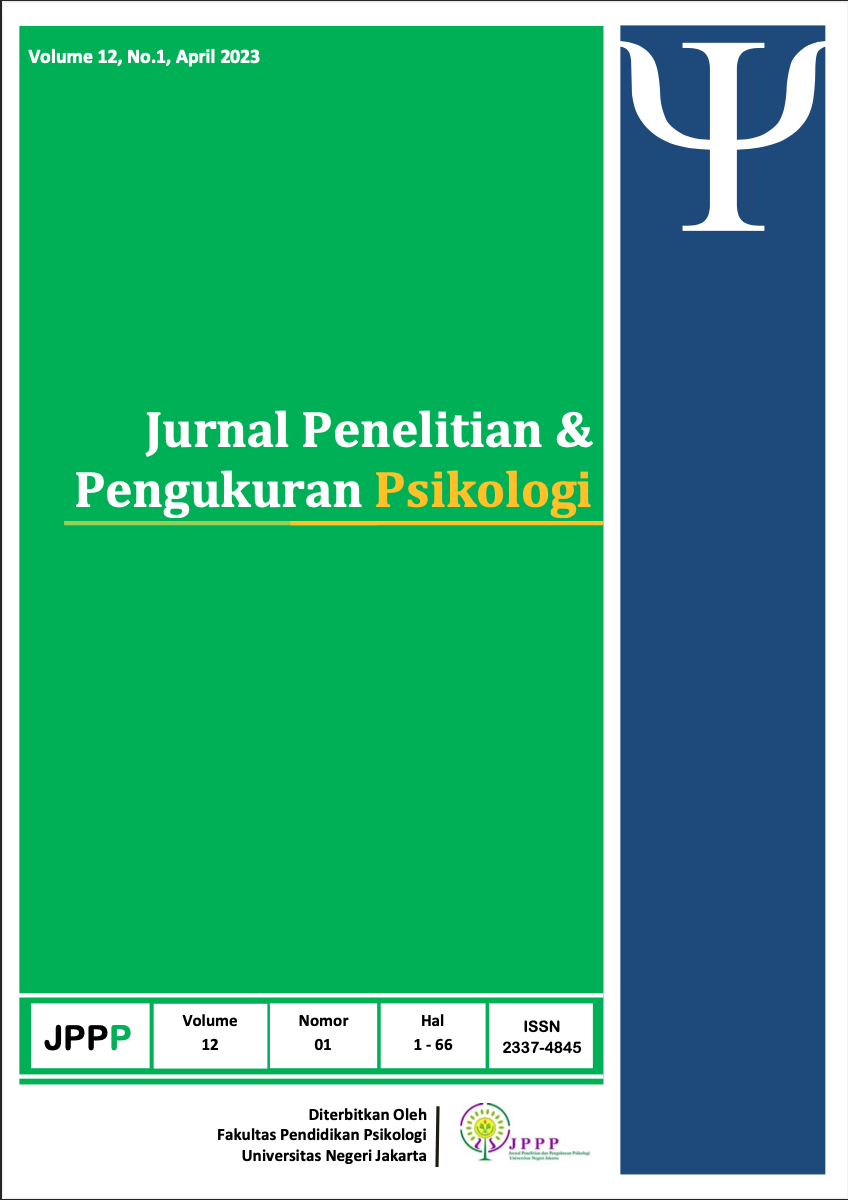Analisis Faktor Konfirmatori Terhadap Skala Cyberloafing Mahasiswa
DOI:
https://doi.org/10.21009/JPPP.121.05Keywords:
Confirmatory Factor Analysis, Cyberloafing, Student Cyberloafing, Student CyberloafingScaleAbstract
The implementation of online distance learning creates a new deviant behaviour in higher education students. There are symptoms of student behaviour who negligent in using the internet for purposes that are not related to learning which is known as cyberloafing. Considering the rapid development of technology, the measurement of student cyberloafing behaviour needs to be developed continuously. Thus, this study aims to develop previous scales related to student cyberloafing to stay up to date.
Based on literature review that discusses the measurement of student cyberloafing, a 20-item scale form created. The data were collected from 506 undergraduate students at a large university in Jakarta who have online distance learning experiences. Data were analysed using Confirmatory Factor Analysis (CFA) with the JASP program. The results of this study indicate that the student cyberloafing scale model is in accordance with the theory where three dimensions are indicated, namely social purpose cyberloafing, academic cyberloafing, dan gaming purpose cyberloafing. The scale has a good fit model based on CFI, TLI, RMSEA, SRMR and GFI.
Keywords: confirmatory factor analysis; cyberloafing; student cyberloafing; student cyberloafing scale
References
Akbulut, Y., Dursun, Ö. Ö., Dönmez, O., & Şahin, Y. L. (2016). In search of a measure to investigate cyberloafing in educational settings. Computers in Human Behavior, 55, 616–625. https://doi.org/10.1016/j.chb.2015.11.002
Amalia, E. (2019). Good governance for zakat institutions in Indonesia: A Confirmatory factor analysis. Pertanika Journal Social Sciences & Humanities, 27(3), 1815–1827.
Andreassen, C. S., Torsheim, T., & Pallesen, S. (2014). Predictors of Use of Social Network Sites at Work - A Specific Type of Cyberloafing. Journal of Computer-Mediated Communication, 19(4), 906–921. https://doi.org/10.1111/jcc4.12085
Barron Rodriguez, M., Cobo, C., Muñoz-Najar, A., Iñaki, ;, & Ciarrusta, S. (2020). multi-country lessons remote learning during the global school lockdown: Global Education and Technology Team Education Global Practice, World Bank Group Rights and Permissions. www.worldbank.org
Baturay, M. H., & Toker, S. (2015). An investigation of the impact of demographics on cyberloafing from an educational setting angle. Computers in Human Behavior, 50, 358–366. https://doi.org/10.1016/j.chb.2015.03.081
Blanchard, A. L., & Henle, C. A. (2008). Correlates of different forms of cyberloafing: The role of norms and external locus of control. Computers in Human Behavior, 24(3), 1067–1084. https://doi.org/10.1016/j.chb.2007.03.008
Brooks, S. K., Webster, R. K., Smith, L. E., Woodland, L., Wessely, S., Greenberg, N., & Rubin, G. J. (2020). The psychological impact of quarantine and how to reduce it: rapid review of the evidence. In The Lancet (Vol. 395, Issue 10227, pp. 912–920). Lancet Publishing Group. https://doi.org/10.1016/S0140-6736(20)30460-8
Brown, T. A. , & M. M. T. (2012). Confirmatory factor analysis. Handbook of structural equation modelling. The Guilford Press.
Charoensukmongkol, P. (2014). Effects of support and job demands on social media use and work outcomes. Computers in Human Behavior, 36, 340–349. https://doi.org/10.1016/j.chb.2014.03.061
Comrey, A. L., & Lee, H. B. (2013). A first course in factor analysis. Psychology Press.
Hair, J. F., Black, W. C., Babin, B. J., & Anderson, R. E. (2010). Multivariate Data Analysis Seventh Edition. Prentice Hall, Upper Saddle River, New Jersey.
Heflin, H., Shewmaker, J., & Nguyen, J. (2017). Impact of mobile technology on student attitudes, engagement, and learning. Computers & Education, 107, 91–99. https://doi.org/10.1016/j.compedu.2017.01.006
Indrawati, B. (2020). Tantangan Dan Peluang Pendidikan Tinggi Dalam Masa Dan Pasca Pandemi Covid-19 . Jurnal Kajian Ilmiah (JKI), 1(1), 39–48.
Karaoğlan Yılmaz, F. G., Yılmaz, R., Öztürk, H. T., Sezer, B., & Karademir, T. (2015). Cyberloafing as a barrier to the successful integration of information and communication technologies into teaching and learning environments. Computers in Human Behavior, 45, 290–298. https://doi.org/10.1016/j.chb.2014.12.023
Peraturan Menteri Pendidikan Dan Kebudayaan Republik Indonesia Tentang Ijazah, Sertifikat Kompetensi Dan Sertifikat Profesi Pendidikan Tinggi, Pub. L. No. 81, Kementerian Pendidikan Dan Kebudayaan (2014).
Kian Yeik, K. (2018). Cyberloafing of ICT Workers in Malaysia View project. http://www.pertanika.upm.edu.my/
Kuss, D. J., & Griffiths, M. D. (2012). Online gaming addiction in children and adolescents: A review of empirical research. Journal of Behavioral Addictions, 1(1), 3–22. https://doi.org/10.1556/JBA.1.2012.1.1
Lim, V. K. G. (2002). The IT way of loafing on the job: Cyberloafing, neutralizing and organizational justice. Journal of Organizational Behavior, 23(5), 675–694. https://doi.org/10.1002/job.161
Maharani, T. (2020, July). Mendikbud: Setelah Pandemi Covid-19, Pembelajaran Jarak Jauh Akan Permanen. https://nasional.kompas.com/read/2020/07/02/14445511/mendikbud-setelah-pandemi-covid-19-pembelajaran-jarak-jauh-akan-permanen
O’Rourke, N., & Hatcher, L. (2013). A step-by-step approach to using SAS® for factor analysis and structural equation modeling. SAS Institute Inc.
Prudon, P. (2015). Confirmatory Factor Analysis as a Tool in Research Using Questionnaires: A Critique,. Comprehensive Psychology, 4, 03.CP.4.10. https://doi.org/10.2466/03.CP.4.10
Ravizza, S. M., Uitvlugt, M. G., & Fenn, K. M. (2017). Logged In and Zoned Out. Psychological Science, 28(2), 171–180. https://doi.org/10.1177/0956797616677314
Sarıtepeci, M., & Sert, U. (2021). Cyberloafing Level of University Students: A Scale Development Study. Research on Education and Psychology, 5(1), 41–52. https://dergipark.org.tr/en/pub/rep/issue/63330/919481
Taneja, A., Fiore, V., & Fischer, B. (2015). Cyber-slacking in the classroom: Potential for digital distraction in the new age. Computers & Education, 82, 141–151. https://doi.org/10.1016/j.compedu.2014.11.009
Vargo, D., Zhu, L., Benwell, B., & Yan, Z. (2021). Digital technology use during <scp>COVID</scp> ‐19 pandemic: A rapid review. Human Behavior and Emerging Technologies, 3(1), 13–24. https://doi.org/10.1002/hbe2.242
Vitak, J., Crouse, J., & LaRose, R. (2011). Personal Internet use at work: Understanding cyberslacking. Computers in Human Behavior, 27(5), 1751–1759. https://doi.org/10.1016/j.chb.2011.03.002
Wu, J., Mei, W., & Ugrin, J. C. (2018). Student Cyberloafing In and Out of the Classroom in China and the Relationship with Student Performance. Cyberpsychology, Behavior, and Social Networking, 21(3), 199–204. https://doi.org/10.1089/cyber.2017.0397
Wu, J., Mei, W., Ugrin, J., Liu, L., & Wang, F. (2020). Curvilinear performance effects of social cyberloafing out of class: the mediating role as a recovery experience. Information Technology & People, 34(2), 581–598. https://doi.org/10.1108/ITP-03-2019-0105
Yadama, G. N., & Pandey, S. (1995). Effect of Sample Size on Goodness-Fit of-Fit Indices in Structural Equation Models. Journal of Social Service Research, 20(3–4), 49–70. https://doi.org/10.1300/J079v20n03_03
Zhong, J., Chen, Y., Yan, J., & Luo, J. (2022). The mixed blessing of cyberloafing on innovation performance during the COVID-19 pandemic. Computers in Human Behavior, 126, 106982. https://doi.org/10.1016/j.chb.2021.106982







